Many people are familiar with the problem of dry hand skin. What to do in this case? Peeling, wrinkling and “parchment” condition of the skin are not only a phenomenon that causes discomfort, but also a signal that you should immediately begin taking care of your hands. First of all, it is worth identifying the reasons for this unaesthetic and discomforting manifestation. Dry hand skin, cracks and other unpleasant symptoms appear for a reason. Let's figure out what circumstances provoke this unpleasant picture?
Dry hand skin: causes
Vitamin deficiency, insufficient care, dry air and other stress factors negatively affect the condition of our skin. As for the hands, as a rule, all these negative influences are reflected first.
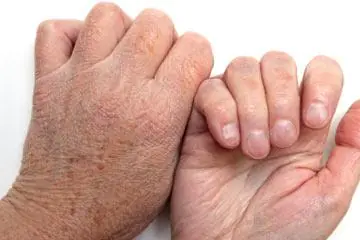
Hand washing with very hot water and aggressive sulfate products has a negative effect. Dry skin may bother you after using the wrong shower gel or liquid soap.
It is advisable to treat your hands with moisturizing and nourishing cream every time after contact with water. As for the choice of cream, it does not have to be expensive: there are very affordable products that cope well with their function. You can only understand whether a cream is right for you or not by trying it.
Diseases that cause dry skin
Unfortunately, dry hand skin can be caused by certain diseases. Creams and masks in this case will be ineffective. If you have very dry skin on your hands, you should consult your doctor. Here are some possible reasons:
- Allergic reaction. This manifestation can be caused by anything - from wearing rings made of the wrong alloy for you to food. A dermatologist will identify the problem, and tests can accurately determine what exactly causes such a reaction.
- Fungal disease. Unfortunately, dry hand skin, cracks and discomfort can be caused by a fungus. This option is especially likely if a person's feet are affected by this disease.
- Iron-deficiency anemia. This disease negatively affects the condition of the body as a whole, including the skin of the hands.
- Increased blood sugar. It's no secret that people with diabetes suffer from dry skin.
- Gastrointestinal diseases. If the body does not have the ability to fully absorb microelements from food, of course, a lack of vitamins will arise, and the poor condition of the epidermis will not take long to occur.
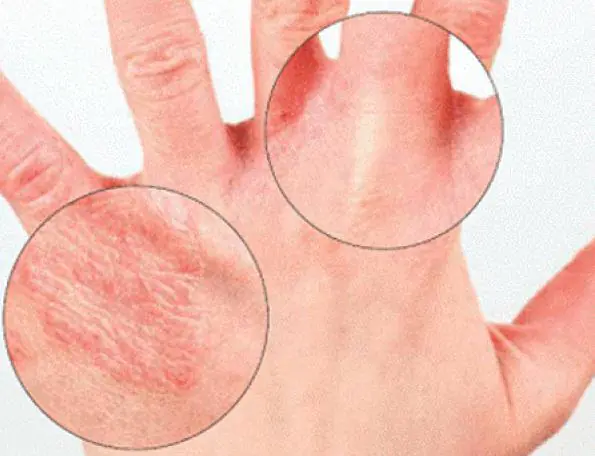
Myths about dry skin
1. A good cream is enough to cope with this problem.
In fact, any skin problem should be approached comprehensively. To completely get rid of dry skin and, as a result, prevent its aging, you should definitely pay attention to your diet, as well as use various procedures to deeply moisturize problem areas.
2. Moisturizing and nourishing hand creams are needed only for dry skin.
It is not true. In fact, all skin needs hydration. And the better the care is chosen, the more comfortable the sensations will be, the longer your hands will look young.
3. Dryness is caused only by a lack of water in the skin.
Actually this is not true. In addition to moisture, the skin needs sufficient fat secretion.
4. Dryness is a genetic predisposition.
Not at all necessary. This unpleasant phenomenon may well be caused by regular improper or insufficient care and a lack of vitamins and microelements.
Where to begin?
First of all, to relieve discomfort, you should use hand cream as soon as possible. After each contact with water and before each exit outside, this manipulation should be performed. If the situation is very advanced and you have very dry skin on your hands, then remember: the richer and more nutritious the cream, the better.
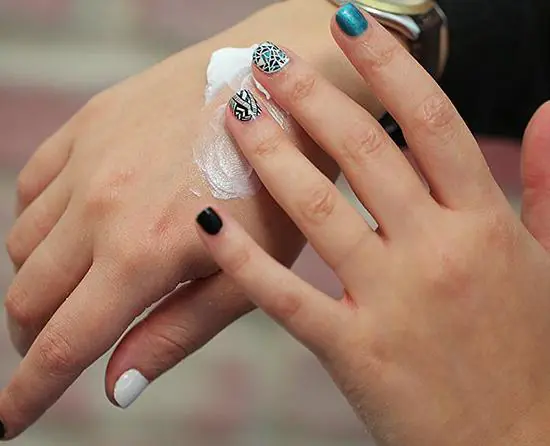
Please note that when combining the oral intake of several vitamins, you should consult a doctor so as not to accumulate an excess of them in the body.
Natural masks for dry hand skin
At home, you can deal with dry hand skin using some products. For example, vegetable sunflower oil helps a lot. It should be slightly warmed up to a comfortable temperature. Then your hands should be soaked in the oil for about 20 minutes, after which the remaining oil from the skin should be wiped off with a napkin.
Baths with olive oil will significantly improve the condition of your skin. To do this, you need to pour a tablespoon of oil into a small amount of warm boiled water and hold your hands in this mixture for half an hour.
Compresses made from mashed potatoes and baths of broth perfectly soften the skin.
If you prefer natural remedies when caring for yourself, you will certainly like the oatmeal mask for dry hands. Oatmeal is one of the few foods that contain hyaluronic acid. Any oil is added to the porridge, after which this mixture is applied to the hands.
Adding oil vitamins, honey and other additives will enhance the effect and healing effects of the product on the skin. Applying homemade mayonnaise prepared on the basis of any vegetable oil and eggs also helps greatly.
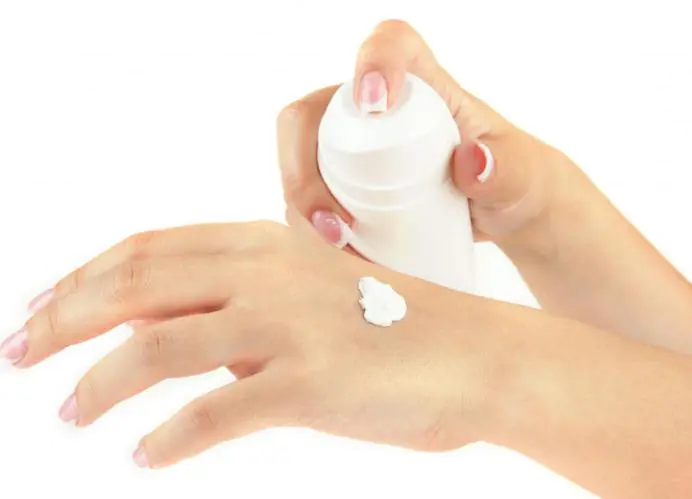
Natural animal fats, such as bear or badger, are very rich in vitamins. After all, these animals hibernate, and their body stores in reserve a balanced and powerful complex of all the microelements necessary for life.
If you have very dry hand skin, it makes sense to increase the duration of any procedure to one hour.
Paraffin therapy - deep skin hydration
Many people know how much discomfort dry skin on the hands can cause. What to do in this case, you ask? A procedure loved by many - paraffin therapy - copes well with dryness. Contrary to the belief that this is a purely salon procedure, it is quite possible to carry it out at home yourself. To do this, you will definitely need special cosmetic paraffin, a couple of plastic bags, two towels and an unnecessary container or other container. Other devices, like a special bath and mittens, of course, make the procedure easier and more enjoyable, but you can easily do without them.
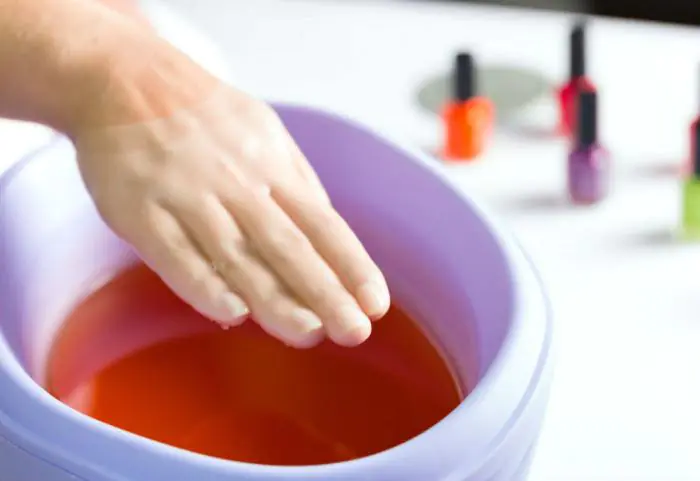
So, the entire pack of paraffin is melted in an unnecessary container in a water bath. While the piece in our container turns into a homogeneous liquid mass, thoroughly scrub the skin of your hands with a scrub for several minutes. This way you will get rid of dead skin particles and allow the nutrients to work harder during the procedure.
When the mixture is completely melted, grease your hands with your favorite cream, then dip them in paraffin. Of course, before immersing your hands entirely, try to see if the temperature of the composition is comfortable to avoid burns. Keep your hands in the paraffin for 10 seconds, then take them out, let the resulting film “set” for a few seconds, then lower them into the composition again. Such dives can be done up to 7 times. Before the last time, bring your fingers together tightly, as a result you should get a very dense layer of paraffin. Then you need to put the bags on your hands and wrap them in towels for 20–30 minutes. During this time, the skin receives deep hydration and nutrition. Blood circulation and metabolic processes are accelerated, the applied cream is intensively absorbed. The sweat released in such “greenhouse” conditions is absorbed back, while all impurities and toxins remain on the paraffin. In addition to the fact that dry skin on your hands will no longer bother you, this procedure allows you to perfectly care for your cuticles, strengthen your nails and accelerate their growth.
At the end, the paraffin films are removed from the hands and thrown away, and the remaining composition remains in the container until the next time.
Treatment with pharmaceuticals
In advanced cases, dry skin on the hands cracks and bleeding wounds appear. In this case, it is necessary to take special care of hand hygiene, disinfect these areas with chlorhexidine or miramistin, and smear the wounds with healing ointment. These can be panthenol-containing drugs, Solcoseryl or any other non-hormonal drug.
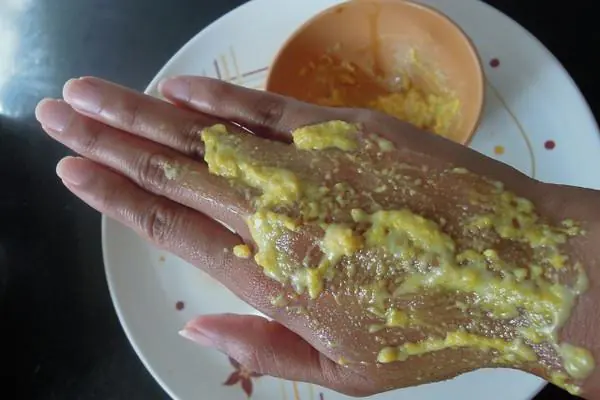
Extra care
Dry skin on your fingers and palms may be caused by not using protective gloves when working around the house. Make it a rule: they should be worn not only when using obvious aggressive chemicals (for example, when washing a toilet, oven, bathtub). For any everyday work around the house that involves contact with cleaning agents and detergents, it is advisable to wear such gloves.
Always dry your hands and do not let them dry on their own. And before going out in the sun, don’t forget to apply sunscreen to this dry and aging area.
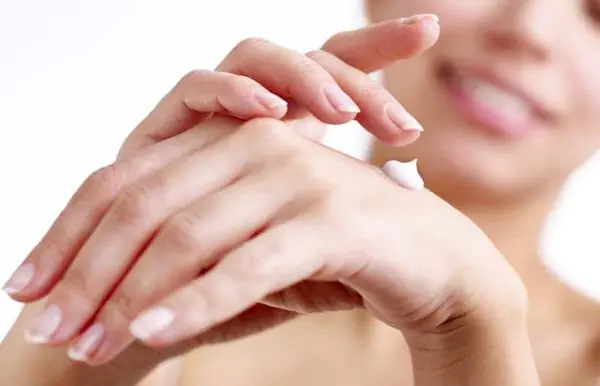
Be sure to exfoliate your hands with a scrub 2-3 times a week. You shouldn't do this more often, but moderate exfoliation never harms the skin. After this manipulation, always apply a nourishing cream.
What to do if you are allergic to hand cream?
Unfortunately, this happens quite often. If you always have an allergy to hand creams, try taking a nourishing protective baby cream. Such products for babies are quite inexpensive, but they do their job remarkably well and practically do not cause allergic reactions.
A little trick
In addition to paraffin therapy, you can also do less energy-consuming procedures at home. Simply wrap your hands with your favorite cream in plastic bags for a period of 20 minutes to one hour.
And remember, the more hydrated the skin of your hands is, the younger, fresher and healthier it will look. By taking care of yourself, paying attention to every detail, right down to the tips of your nails, you will look much younger than your age.
Many people who experience dry skin know that it can cause a lot of problems. Tightening, finely porous structure, irritation, dull color, flaking and itching - these uncomfortable sensations can be upsetting and make you think about finding ways to combat them. In addition, dry skin is more susceptible to wrinkles and ages faster.
In this article we will tell you about the causes of dry skin and methods of treatment. Such knowledge will help you get rid of the unpleasant sensations it can cause and prevent the formation of premature wrinkles.
Signs of dry skin
You can determine dry skin yourself: when you apply pressure with your fingers, marks on its surface do not disappear for a long time. There are also other signs:
- tightness;
- invisible pores;
- frequent irritation (redness);
- peeling;
- lack of elasticity;
- cracks.
As the top layer of skin dries out, it loses its integrity and dirt, bacteria and chemicals can pass through the resulting microcracks. Subsequently, these foreign agents can cause irritation and itching.
Causes
Dry skin is caused by inhibition of sebum production, which is provoked by a number of reasons. In some cases, such ineffective functioning of the sebaceous glands is caused by a hereditary predisposition. Dermatologists note that dry skin in young people often indicates a genetic trait, while in older people it appears due to other internal or external factors.
The main external causes of dry skin are as follows:
- dry air;
- climate;
- hot and cold water;
- prolonged exposure to the sun;
- freezing;
- improper skin care (aggressive cosmetics, frequent washing with soap, etc.).
The main internal causes of dry skin:
- dehydration (insufficient water consumption, indigestion, high fever, etc.);
- hormonal imbalances (diabetes mellitus, hypothyroidism, menopause, etc.);
- metabolic disease;
- frequent stress;
- long-term use of antibiotics;
- hypovitaminosis (especially A and E);
- skin diseases (allergies, keratosis, eczema, dermatitis, psoriasis, fungal infections, etc.);
- poor nutrition and exhausting diets;
- bad habits (smoking, excessive consumption of sweet tea and coffee, carbonated drinks);
- aging.
Dry skin can be general or affect specific areas of the body. This or that localization of such zones may indicate the cause of their appearance, and various means can be used to eliminate and treat it.
Treatment options for dry hands and fingers
Dry hands and fingers are often caused by external factors. Washing dishes without gloves with aggressive substances or in hot water, cold air, using antibacterial or deodorized soap, working on the ground, working with construction mixtures - these are not all the factors that contribute to dry skin. Particular attention should be paid to the formation of cracks on the fingers. This symptom may indicate insufficient intake of vitamins A, E and group B into the body.
To eliminate and treat dry skin of the hands and fingers, a number of measures should be taken:
- use cotton or rubber gloves when working with aggressive substances;
- wear warm mittens or gloves during the cold season;
- use sunscreen;
- Gently dry the skin of your hands after washing with a soft towel;
- use soft and high-quality detergents for washing hands;
- normalize nutrition;
- pay attention to a sufficient intake of vitamins A, E and group B.
Treatment of dry hand skin can be carried out using pharmaceutical wound-healing creams and various folk recipes.
Traditional medicine recommends the use of various wound-healing, nourishing and moisturizing baths, compresses and masks:
- Potato mask – boil potatoes in their skins, peel and mash into a paste. Add a tablespoon of warm milk to it. Apply a warm mask to the skin of your hands for 20 minutes for several days in a row, 2-3 times a day.
- Compress made of honey and glycerin - take 1 teaspoon each of honey, glycerin, water and flour. Mix the ingredients until smooth and apply the mixture to your hands. Wear cotton gloves for 20 minutes. It is better to do such compresses several times a day for a week.
- Sour cream compress – mix a glass of rich sour cream with egg yolk and lemon juice. Moisten the gauze with the resulting mixture and apply it to your hands, secure the top with cling film and put on gloves or wrap your hands in a warm towel. After 20 minutes, remove the remaining compress with a cotton pad and put on clean cotton gloves. It is better to do such compresses before going to bed for several days.
- Mask of olive oil and lemon juice - mix a tablespoon of oil with 1/2 teaspoon of lemon juice and 1 teaspoon of hand cream. Before going to bed, apply the mixture to the skin of your hands and put on cotton gloves. This mask can be used once a week for prevention or for several days to treat dry skin on the hands.
- Oil bath - pour olive, sunflower or flaxseed oil into a small bowl and heat in a water bath to a comfortable temperature (it should be very warm). Immerse your hands in the oil for 20 minutes. After this, dry your hands with a napkin. It is recommended to carry out such procedures 2 times a week.
The following folk recipes are used to treat cracked fingers:
- Ointment from oleoresin and honey - in a metal bowl mix 10 g of oleoresin, 10 g of honey, 15 g of beeswax and 30 ml of vodka. Place on the fire and, stirring constantly, wait until all ingredients are completely dissolved. Pour the ointment into a clean glass container and store in the refrigerator. To treat, apply the product to the crack and cover with a bactericidal adhesive plaster. Leave for 7–8 hours.
- Plantain ointment - grind the dry herb into powder, mix with 3 drops of oil and add Vaseline (in a ratio of 1:9). Apply in the same way as ointment made from oleoresin and honey.
- Calendula ointment - grind half a glass of dried calendula flowers into powder and mix with one glass of melted lard. Place the mixture in a water bath and, stirring constantly with a wooden spatula, bring to a homogeneous consistency. Pour into a glass container and store in the refrigerator. Apply in the same way as ointment made from oleoresin and honey.
If you have dry hands or cracked fingers, a dermatologist can recommend vitamin and mineral complexes; choosing them yourself is not recommended.
In some cases, dry and flaky hands can be caused by fungal diseases. The skin becomes covered with spots of different sizes and colors (from pink to slightly bluish), and the patient may experience itching and burning. At the folds it can crack and form white flaky islands. Proper treatment of such fungal infections of the skin of the hands is prescribed only by a dermatologist after laboratory tests are performed to determine the type of fungus. Only after this will the doctor be able to prescribe antifungal drugs and determine the duration of their use.
Treatment options for dry elbows
Dry skin on the elbows can be caused by many external and internal reasons. Peeling in this area is provoked by mechanical stress (for example, when working in an office) or frequent bathing. It can also be caused by various diseases.
The most common causes of dry elbows are:
- hypothyroidism - this disease leads to a slowdown in metabolism and skin regeneration, epidermal cells die off, do not have time to exfoliate and the skin becomes dry and rough;
- iron deficiency anemia - lack of iron leads to a decrease in hemoglobin and a lack of oxygen in tissues, metabolic disorders cause dry skin;
- diabetes mellitus - a metabolic failure causes a disruption in the nutrition of all tissues of the body, the skin becomes dehydrated, becomes vulnerable and thin, areas of inflammation and itching appear;
- autoimmune and dermatological diseases - atopic dermatitis, neurodermatitis, scleroderma, skin ichthyosis and other diseases lead to peeling and roughening of the skin.
Treatment for dry skin on the elbows is aimed at eliminating the cause that causes this symptom. In addition to treating the underlying disease, the use of creams with chamomile and alfalfa, Lipikar balm, Pitival and Atoderm creams, Radevit ointment, oils (cocoa, shea, mango, etc.) and folk recipes may be recommended.
Traditional medicine recommends the following remedies for dry skin on the elbows:
- Coffee grounds and honey scrub – add honey to coffee grounds, apply to elbows and massage in circular motions to remove dead skin cells. Rinse with warm water and apply nourishing cream or oil.
- Compresses made from sour cream and sunflower oil - mix the ingredients in equal proportions, apply the mixture to gauze and apply to the elbows, wrap in a warm cloth and leave for 10-20 minutes.
- Milk baths – heat the milk and immerse your elbow in it for 20 minutes. Blot with a napkin and repeat the procedure on the other hand.
Methods of treatment for dry skin
Dry facial skin can be explained by hereditary predisposition, external factors, age-related changes or disruption of the sebaceous glands. A decrease in the level of sebum secretion can be provoked by various diseases of the gastrointestinal tract, endocrine or nervous system and a lack of vitamins A, E and group B. To treat these pathologies, a consultation with a doctor is necessary, which will help identify the cause and determine the course of treatment for the underlying disease.
To prevent the development of this problem, it is necessary to minimize the aggressive effects of the environment and provide the skin with proper care. Washing and caring for such skin should be carried out only with the help of special products. You can also use various homemade nourishing and moisturizing products.
Traditional medicine suggests using the following masks for dry skin:
- A mask of plum, melon and jojoba oil - take all ingredients in equal proportions. Grind the plum and ripe melon pulp with a fork until pureed. Add oil and mix thoroughly. Apply to face and rinse with warm water after 20 minutes.
- Mask of egg yolk, vegetable oil and chamomile - beat the egg yolk with a teaspoon of vegetable oil (almond, flaxseed, sunflower, olive, etc.), add a tablespoon of pharmaceutical chamomile extract and beat again. Apply the mixture to your face and rinse off after 10–15 minutes with slightly warm water.
- Mask of oatmeal and olive oil - boil the flakes in milk. Take 3-4 tablespoons of porridge, add the same amount of olive oil to it and beat. Apply a thick layer to the face. Rinse off after 15 minutes with warm water and rinse your face with cool water.
Methods for treating dry skin on the body
General dry skin on the body can also be caused by external factors, but most often it is caused by diseases of the internal organs. To treat it, it is necessary to identify the cause and eliminate it. In addition to getting rid of the effects of external factors (hot water, aggressive detergents, prolonged exposure to the sun, etc.) and treating the underlying disease, it is recommended to maintain a normal drinking regime, eat a sufficient amount of dairy products, fish, vegetable oils, broccoli, nuts and seafood .
To moisturize and nourish the skin after hygiene procedures, various cosmetics for dry skin with ceramides, fatty acids and lipids should be used. You can also use various folk recipes for baths, masks and peelings:
- Peeling with honey, sea salt and olive oil - mix 4 tablespoons of honey and 1 tablespoon of fine sea salt, add a tablespoon of olive oil to the resulting mixture and stir. Apply to cleansed body skin and massage lightly. After 5 minutes, take a warm shower.
- Bath from a decoction of flaxseed and chamomile - boil 5 teaspoons of flax seeds in a liter of water for about 15 minutes, prepare a decoction of chamomile (the recipe is indicated on the package). Mix both decoctions in a 1:1 ratio and add to 1/2 of the bath. The duration of the procedure is about 15 minutes.
- Bath of milk, almond butter and honey - heat a liter of milk and add 200 honey to it, mix with a dessert spoon of almond butter. Pour the composition into the bath. The duration of the procedure is about 15–20 minutes.
- Honey and olive oil mask – mix honey and oil in a 1:1 ratio, apply to cleansed body skin and leave for 20 minutes. Take a warm shower.
- Mask of avocado, banana, cream and butter - grind the pulp of one avocado and banana with a fork until pureed, add 100 g of butter, 1/2 cup of cream to the mixture and beat everything thoroughly. Add a few drops of rose oil and beat the mask again. Apply to cleansed body skin for 15 minutes. Take a warm shower using a washcloth.
Treatment options for dry skin on feet and heels
Dry skin on the heels and feet can be caused by wearing uncomfortable shoes, insufficient amounts of vitamins A and E, diseases of the endocrine system and fungal infections. In some cases, all these reasons can lead to the formation of cracks in the area of roughened skin, which cause a lot of discomfort and pain.
If such a problem was caused by uncomfortable shoes, then it is enough to get rid of them and choose shoes taking into account the size and shape of the foot. Treatment of dry skin on the feet and heels should be aimed at eliminating the underlying disease. To do this, you will need to consult an endocrinologist or dermatologist. Lack of adequate treatment will lead to worsening of the underlying disease and the development of complications.
For local treatment of dry skin of the heels and feet, various agents can be used: emollients, exfoliants, antibacterial and wound healing. Their choice depends on the condition of the skin.
To eliminate very dry skin on the heels and feet, traditional medicine offers the following recipes:
- Green apple mask – grate one apple on a fine grater, put the puree on gauze and apply it to the foot. Put on socks. Leave the compress overnight. In the morning, wash off the mask and apply nourishing cream to the skin.
- Potato and flaxseed mask - grate raw potatoes on a fine grater, add the same amount of flaxseed, add a little water and boil the mixture until thick. Allow to cool slightly and apply to feet. After 20 minutes, rinse with warm water, remove areas of flaky skin and lubricate your feet with iodine.
- Masks with castor oil - moisten gauze with oil and apply to the foot or heel. Wear warm socks and leave overnight. In the morning, blot your skin with a napkin.
To treat cracked heels, you can use folk recipes that were described above for the treatment of cracked fingers. The use of such means also gives good results:
- Glycerin with ammonia - mix the ingredients in a 1:1 ratio and apply to steamed legs. Put on socks. Apply until cracks and rough skin disappear.
- Apple cider vinegar – add the same amount of water to 20 ml of vinegar. Soak a piece of gauze in the solution and apply it to your feet, put on socks and leave overnight. In the morning, wash your feet and remove softened areas of rough skin. Lubricate the cracks with an antibacterial agent, apply nourishing cream to the feet.
With fungal infections of the feet, areas of redness form on the skin, which can subsequently peel off, become painful and itchy. Treatment of such diseases can be prescribed only after laboratory tests are carried out, which determine the type of fungus and allow the doctor to select the necessary drug and determine the duration of therapy.
Dry skin is not just a cosmetic problem. Such a sign may indicate a disease, improper care, lack of vitamins, age-related changes and hereditary predisposition. There are many cosmetics and folk remedies to solve this problem, but before using them, be sure to determine the cause of dry skin. This way you can prevent the progression of the disease and the development of complications that it can cause.
Which doctor should I contact?
To get rid of dry skin, you need to contact a dermatologist or cosmetologist who will recommend care products. At the same time, you need to visit a therapist and undergo an examination to identify the cause of such dryness. If necessary, a consultation with an endocrinologist, gynecologist, mycologist (for fungal skin diseases), allergist (for atopic dermatitis), hematologist (for anemia), rheumatologist (for scleroderma) is prescribed. It is recommended to consult a nutritionist regarding nutritional advice.
We only think about hand cream in winter, when the skin cracks and peels from frost and wind. But it’s better not to take it to extremes and always keep a tube of cream with you - especially if the skin on your hands is dry. By the way, now we’ll tell you why she becomes like this and what to do about it.
Content
- Dry skin: main signs
- Causes of dryness
- Proper care for dry hand skin
- Seasonal care
- Hand baths
- Diet rules for dry skin
- Preventive measures
- Review of care products
Dry skin: main signs
Dry skin can be caused by both genetic predisposition and external factors - the use of poorly selected cosmetic products or harsh weather conditions.
Dry skin does not retain moisture well because its natural protective layer, the hydrolipid mantle, is damaged. Particularly often, areas with thin skin suffer from this problem: eyelids, arms, neck, décolleté.
Causes of dryness
Frequent hand washing with aggressive cleansers and the use of bactericidal gels (especially important for doctors and nurses).
Using household chemicals without gloves.
Using a scrub too often and, as a result, compromising the integrity of the protective barrier of the epidermis.
Working with chemicals, solvents and other aggressive substances.
Extreme weather conditions: heat or, conversely, severe frost and icy wind.
Low indoor air humidity is a common winter problem, since when the central heating is turned on, the air tends to be dry.
To prevent your hands from becoming dry, wear gloves when cleaning and washing dishes. © iStock
Proper care for dry hand skin
Note, what do you wash your hands with and how often? you do it. If dryness and cracks on the skin of your hands are your constant problem or your job requires you to wash your hands many times a day, change the classic bar or liquid soap to a more gentle cream cleanser.
Important limit contact of the skin of your hands with household chemicals, for example, when washing dishes: use gloves or replace products with moisturizers and hypoallergenic ones.
Hand scrub is not very popular, but it doesn’t hurt to get one. Regular (a couple of times a week) exfoliation removes dead particles of the epidermis and causes cells to renew faster. The skin not only becomes softer and more tender, but also better accepts the beneficial substances that are included in subsequent care products.
Hand cream should be on every woman's bedside table (you can throw the second one in your bag, and the third one in your office desk drawer). Without it, the skin on your hands will become wrinkled ahead of time.
As an emergency treatment for quick recovery, use hand mask: This can be either a special product or any fatty cream applied in a thick layer. Wear cotton gloves on top.
Use hand cream several times a day. © iStock



